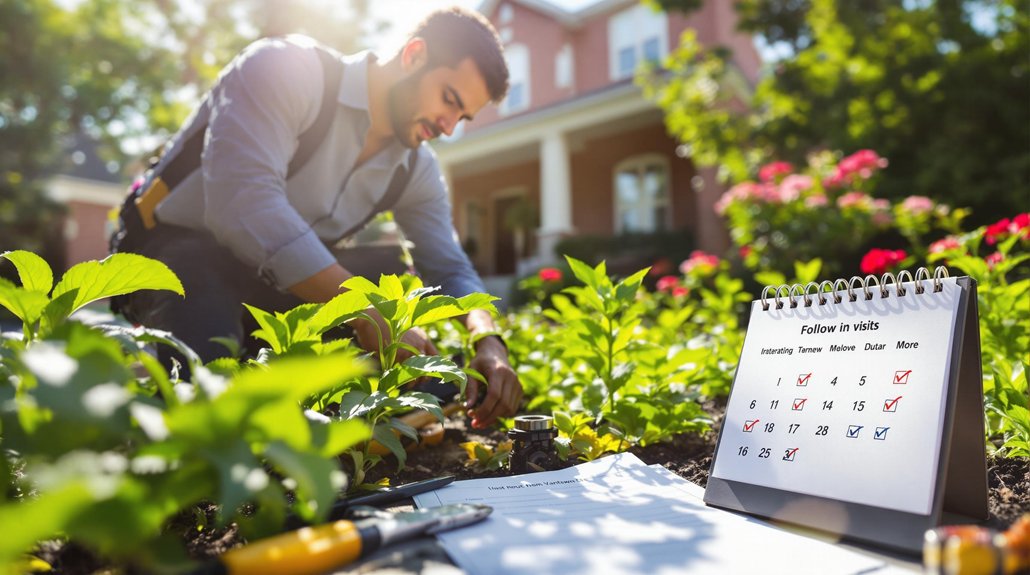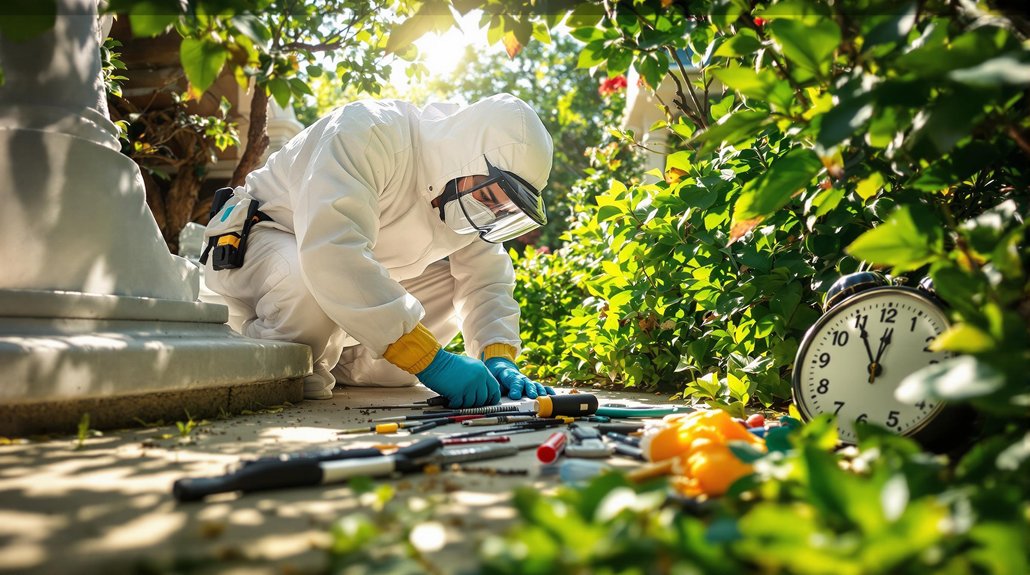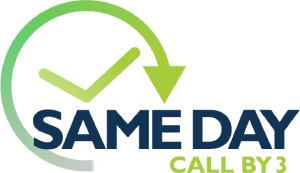The duration of a pest control job in San Antonio depends on several factors. These include the type of pest being treated, the methods used, and the size of the area. Initial inspections usually take 30 to 60 minutes. Chemical treatments are often quicker, while biological methods may take longer. Follow-up visits are important to guarantee effectiveness. Homeowners can prepare to enhance treatment success. There are more details about the process ahead.
Key Article Highlights
- The duration of a pest control job varies based on the type of pest being treated, with some needing quicker methods than others.
- Initial inspections typically take between 30 minutes to an hour, depending on property size and infestation complexity.
- Chemical treatments are usually faster, whereas biological treatments may extend job timelines due to slower results.
- Follow-up visits are essential for monitoring effectiveness and may add additional time to the overall pest control process.
- Proper home preparation and communication with the pest control team can enhance treatment efficiency and reduce overall job duration.
Factors Influencing Pest Control Duration
When considering how long a pest control job might take, several factors come into play. First, the type of pest being treated affects the duration. Some pests require quick treatments, while others may need more time for effective control. Second, the chosen pest control methods can influence how long the job lasts. For instance, chemical sprays might take less time compared to traps or bait systems that require installation and monitoring. Additionally, the size of the area being treated is important; larger spaces may require extended efforts. For example, liquid soil treatments can be essential for effectively eliminating termite infestations, which may prolong the job duration. Finally, treatment effectiveness can also impact duration, as repeated applications may be necessary for certain pests. Understanding these factors helps set realistic expectations for pest control jobs. Moreover, implementing routine inspections can help identify pest issues early, potentially reducing the overall time required for effective treatment. Additionally, managing standing water is crucial since it can contribute to mosquito breeding, thereby complicating pest control efforts.
Initial Inspection Process
The initial inspection is a vital step in pest control. It helps to identify specific pest problems and assess the extent of the infestation. Various factors can influence how long this inspection takes, such as the size of the property and the type of pests involved.
Purpose of Initial Inspection
An initial inspection serves as an essential step in the pest control process. During this phase, professionals use pest identification strategies to determine the type of pests present in a home or business. This identification is significant as it influences the choice of treatment methods. The inspection also helps to assess the level of infestation and identify potential entry points. After the inspection, an inspection report is generated, highlighting findings and recommended actions. This report holds importance as it serves as a reference for both the pest control team and the property owner. By clearly outlining the issues and proposed solutions, the report guarantees that all parties understand the necessary steps to effectively manage the pest problem.
Inspection Duration Factors
How long does an initial inspection typically take? The duration of an initial pest control inspection can vary based on several factors. First, the size of the property plays a significant role; larger spaces require more time to inspect. Second, the inspection techniques used by the pest control professional can affect the length of the process. Some techniques involve detailed examinations of hidden areas where pests may reside. Additionally, understanding pest behavior is important. If the pests are elusive or the signs of infestation are subtle, the inspector may need extra time to gather evidence. Finally, the complexity of the situation, including prior infestations, can also extend the inspection duration. Overall, it averages between 30 minutes to an hour.
Identifying Pest Problems
After the initial inspection, the next step involves identifying specific pest problems. Pest identification techniques are vital during this phase. Technicians look for signs of infestation, such as droppings, nests, or damaged materials. They may also check for unusual sounds or odors that indicate pest presence. Each pest type has unique indicators, which help in diagnosing the issue accurately. The technician gathers information about the location and extent of the infestation. This process is essential for developing an effective treatment plan. By recognizing the signs of infestation early, property owners can prevent further damage and guarantee a swift response. Accurate identification paves the way for effective pest control measures tailored to the specific problem.
Treatment Options and Their Impact on Time
When considering pest control, the choice of treatment can greatly influence the duration of the job. Different treatment options come with varying levels of treatment effectiveness and treatment frequency, affecting how long the process takes.
- Chemical Treatments: Typically fast-acting, but may require frequent applications for continued effectiveness. To effectively eliminate bed bugs, these treatments often target adults, nymphs, and eggs during the process. Additionally, residual sprays are commonly used in these treatments to ensure lingering protection against pests.
- Biological Treatments: Often slower to show results, which may extend the timeline of pest control jobs.
- Integrated Pest Management (IPM): This holistic approach may take longer due to its focus on prevention and monitoring, but it can lead to long-term solutions. Austin pest control employs this strategy to effectively manage pests.
Understanding these options helps clients anticipate the time commitment needed for effective pest control. Choosing the right treatment can guarantee a successful outcome while minimizing time spent.
Follow-Up Visits: What to Expect

Follow-up visits are an important part of the pest control process. These visits help guarantee that the initial treatment is effective and that any remaining pests are addressed. During follow-up visits, technicians assess the situation and check for signs of pest activity. They may conduct additional treatments as needed based on their findings. The follow-up procedures are designed to monitor the results of the initial treatment and to enhance treatment effectiveness. Homeowners should be prepared for these visits, as they play a vital role in achieving long-term pest control. Overall, regular follow-ups help confirm that the pest problem is fully resolved and can prevent future infestations from occurring.
Seasonal Considerations for Pest Control
As seasons change, the types of pests that invade homes can also shift considerably. Understanding these seasonal pests is essential for effective pest control. Weather patterns play a significant role in pest activity, influencing when and how often infestations occur.
Key seasonal considerations include:
- Spring: Ants and termites begin to emerge as temperatures rise, and this is also a time when insect growth regulators can be effectively used to manage their populations.
- Summer: Mosquitoes and flies thrive in warmer weather, increasing their presence.
- Fall: Rodents seek shelter indoors as temperatures drop, making homes more vulnerable. This is a critical time to implement exclusion repairs to prevent rodent access and activity.
Common Pests and Their Treatment Timelines

How long does it take to address common pests effectively? The timeline for pest control varies by the type of pest. For instance, bed bug treatment can require multiple visits over a few weeks. This guarantees that all life stages of the bugs are eliminated. On the other hand, a termite inspection is typically completed in one day, but treatment may take longer depending on the severity of the infestation. Termite treatments often involve drilling and applying pesticides, which can take several hours. Other pests, such as ants or roaches, may be addressed in a single visit but could require follow-ups. Understanding these timelines helps homeowners plan accordingly for effective pest management.
Tips for Preparing Your Home for Pest Control
Preparing a home for pest control is important for effective treatment. Homeowners should clear cluttered areas, secure food items, and inform the pest control team about any specific concerns. These steps help guarantee a smooth and successful pest control process.
Clear Cluttered Areas
A well-organized space can considerably enhance the effectiveness of pest control treatments. Clutter removal and organizing spaces are essential steps in preparing a home for pest control. When areas are free of unnecessary items, pest control professionals can work more efficiently.
To clear cluttered areas effectively, consider these tips:
- Remove unnecessary items: Get rid of things that are not needed, making the space easier to treat.
- Organize furniture: Move furniture away from walls to allow access to all corners.
- Create clear pathways: Make certain that pest control staff can move freely around the home.
Secure Food Items
Securing food items is an essential step in preparing for pest control treatments. Proper food storage helps prevent pests from accessing potential food sources. Homeowners should begin by removing all food from countertops and tables. It is important to store food in airtight containers, as this reduces the chances of pests infiltrating them. Additionally, perishable items should be placed in the refrigerator or freezer. Cleaning up spills and crumbs is vital for effective pest prevention, as it minimizes attractants. All pet food should also be stored securely, away from areas where treatments will occur. By ensuring that food items are properly secured, homeowners can support the pest control efforts and create a cleaner, safer environment.
Inform Pest Control Team
Before the pest control team arrives, it is important for homeowners to inform them about any specific issues or concerns related to pest activity. Effective pest control communication can greatly enhance team efficiency. Homeowners should consider sharing the following details:
- Types of pests observed in the home
- Areas of the home with significant pest activity
- Any previous pest control treatments conducted
Frequently Asked Questions
How Much Does Pest Control Typically Cost in San Antonio?
In a bustling city, pest control pricing fluctuates like the seasons. Typically, average service rates in San Antonio range from $100 to $300, depending on the pest type and extent of the infestation.
Are There Any Health Risks Associated With Pest Control Treatments?
Health concerns may arise from pest control treatments, particularly if chemicals are involved. Ensuring treatment safety is essential to minimize risks. Proper precautions and following guidelines help protect both people and pets during the process.
What Should I Do if Pests Return After Treatment?
If pests return after treatment, he should implement pest prevention tips and contact the pest control service for follow-up treatments. Regular inspections and maintaining cleanliness can also help reduce the chances of pests returning.
Can I Stay in My Home During Pest Control Treatments?
During pest control treatments, individuals may stay in their homes, but treatment duration and safety precautions must be considered. It’s important to follow guidelines provided by the pest control professionals for ideal safety and effectiveness.
How Do I Choose the Best Pest Control Company?
Choosing the best pest control company involves checking pest control certifications and considering eco-friendly options. Coincidentally, many top companies offer both, ensuring safety and effectiveness. Research, read reviews, and compare services for informed decisions.
Call today if you are in need of a pest exterminator in San Antonio, TX
(210) 796-6593

